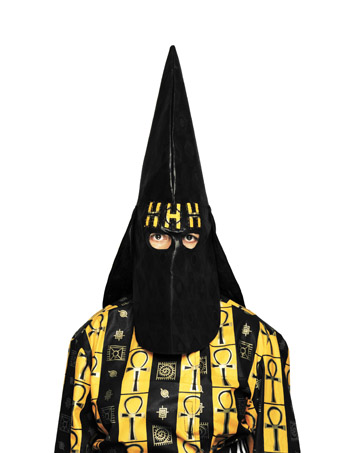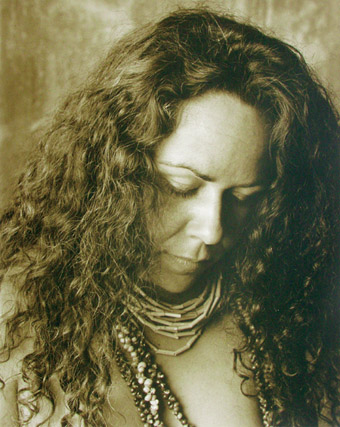seeing black: degrees of invisibility
djon mundine: fiona foley

HHH #2 2004, Fiona Foley, image courtesy the artist, Andrew Baker Art Dealer, Brisbane and Niagara Galleries, Melbourne
© the artist, photo Dennis Cowley
HHH #2 2004, Fiona Foley, image courtesy the artist, Andrew Baker Art Dealer, Brisbane and Niagara Galleries, Melbourne
A 25-YEAR RETROSPECTIVE OF FIONA FOLEY’S WORK IS CURRENTLY SHOWING AT SYDNEY’S MCA. WHO IS THE REAL FIONA FOLEY? SHE ONCE SCOFFED WHEN I SUGGESTED SHE CREATE A PERFORMANCE PIECE DRESSED AS A BONNETED ELIZA FRASER OF FRASER ISLAND FAME. FOLEY HAS APPEARED IN MANY GUISES: A DEFIANT, SEMI-NUDE BADTJALA WOMAN IN NATIVE BLOOD (1994) AND BADTJALA WOMAN (1995); IN COSTUME AS A SEMINOLE INDIAN MAIDEN (WILD TIMES CALL, 2001); A MASKED AFRICAN-AMERICAN REVERSE KU KLUX KLANNER (HHH—HEDONISTIC HONKY HATERS, 2004).
Foley was present only symbolically in earlier works: her hair clippings in Lost Badtjalas (1991) and in the red chilli and charcoal floor installation Black Velvet II in Meridian at the MCA in 2002. She is visible only as her ‘spoor’— a predator lurking—in the photographic sets Venus and Sea of Love (2007) and more recently as a burkah-clad Islamic Australian woman in Nulla 4 eva (2008). “Nulla”, I’m told, is the local colloquial name for the Sydney suburb of Cronulla. “If you are an ‘other’, can you then be any and all ‘others’? With all the dress-ups, is it just a fashion shoot?”, I once asked. “I don’t think so!”, flew the reply. Paris is Burning perhaps?
roles & masks
Notably Fiona Foley is not alone in this fascinating ‘role-playing’ that has formed a special part of her work. A number of Aboriginal artists have adopted various guises/forms in their work, some blatantly—Tracey Moffat, and later Darren Siwes and Christian Thompson. Others have played with pseudonyms of a kind—Gordon Bennett as John Citizen and, soon after, Richard Bell as Richie—or used masked people as Tony Albert does in No Place (2009). Ego, parody, comedy, wit, shyness or shame?
At the memorial service in 2007 for acclaimed Aboriginal actress Justine Saunders at Sydney Opera House, her partner mulled over his feelings that despite her success in many roles, colonial history and racism within Australia forced Justine from early in her life to carry a deep hurt, a wound, “hidden inside, to question her own self-worth”, he said. This burden scars how many Aboriginal people?
Feminist discussions of the body usually propose a liberating confessional self-representation while post-colonial histories often began with autobiographical telling and imagery. Though cathartic this approach can also fail, clumsily reducing the personal to just another form of stereotype.
speaking through objects
Fiona Foley’s inclusion of herself in her work appears early in her career though in a quite different way, almost ritualistic and honorific. Majoring in sculpture at art school, she took to installation of objects or series of related images around certain concepts. More often than not she was invisible, speaking through objects and other people in her image series. Of late, she has laid out her ideas in constructed sets of photographs accompanied by auxiliary objects. In 2001, the floor of the Tampa Florida Gallery was covered with 30cm deep golden, ripe corn that visitors had to struggle through to view the soft sepia images of Wild Times Call. In her 2004 series, HHH, colourful costumes, like a set of eyeless ghosts, stare out in contrast to the simmering, hateful gaze in the HHH photo series next to which they hang. In Black Opium (2006), a set of traditional Australian Chinese opium pipes accompanies the painting series, and in the MCA show Foley adds her evocative short film, Bliss (2008).
The seven images comprising the recent Nulla 4 eva series (2008) portray a truly multicultural nation. Several social issue sites are visited including the little remembered but historically significant 19th century Chinese opium house meeting place and a playful, if reserved, youthful, contemporary ‘Cronulla’ beach scene. Aboriginal and non-white youths pose slightly self-consciously on the beach—the boys semi-naked, the girls ‘coiffured’ and wearing a variety of outfits that reflect a range of cultural backgrounds. Here, all are ‘wrapped up’ and yet appear perfectly comfortable in assemblage and setting.
an unofficial historian
There is more than one history, even though white, western history dominates. In Australia there is a lack of national in-depth engagement with this history except for our narrow, official, paper-thin view. The ‘history wars’ debate has been intense and highly political over the last decade and still smoulders. Meanwhile, Fiona Foley has taken on the role of a kind of unofficial historian. Nobody has asked for or authorised this role but the history she explores is in fact our common national history, from both sides of the racial divide. Beyond its strong visual appeal, it’s really in this context that I believe her art should be read.
One of the first laws enacted concerning Aboriginal people in Queensland was The Protection of Aboriginals and the Restriction of the Sale of Opium Act (1897). Foley’s Opium—Shackled and Bliss (2008) both talk of the place of Chinese Australians and their relationship with both black and white Australia. Historically this active and visible engagement has been only lightly recorded.
More recently, the Cronulla ‘incident’ was one of contestation, historically as well as physically: contestation of the site—the beach as an Australian social interactive space, for many a ‘sacred’ place. Aboriginal people were never asked for comment about the incident—white Australians simply claimed the site (to keep an escape route open perhaps?). There was no reference to Aboriginal history even though many Sydney coastal and harbour beaches carry Aboriginal names—Akuna Bay, Barrenjoey, Bilgola, Bondi, Coogee, Curl Curl, Dee Why, Elanora, to name just a few.
Successive waves of migrants have washed up on our shores—each challenged as they arrived by the previous wave, each vilified and to an extent subsumed and then dismissed. They are all strangers to us Aboriginal people. Who owns the beach? Aboriginal people, if anyone.

Native Blood 1994, Fiona Foley, image courtesy the artist, Andrew Baker Art Dealer, Brisbane and Niagara Galleries, Melbourne
© the artist
Native Blood 1994, Fiona Foley, image courtesy the artist, Andrew Baker Art Dealer, Brisbane and Niagara Galleries, Melbourne
the artist as auditor
Fraser Island is often called the world’s largest ‘sand island.’ To know your country means to watch each small, warm movement, to see movement when there seems no movement, to recognise the residual shadow of each being present and passing.
Fiona Foley has spent long periods of time engaged in auditing Fraser Island in several series of single sign drawings of flowers blooming, skulls, footprints, seed pods, fish bones, nautilus shells, middens, tide lines of leaves, birds, feathers, dingos, flotsam and jetsam. In 2006 she left her own marks in Signpost 1 and 11.
Song-lines—creation begins with the sunrise and a spirit being who crosses the land seeing, hearing, naming and animating the environment. The late 1980s found Fiona Foley working in Maningrida and Ramingining in Arnhem Land where she spent time with local artists Jack Wununwun and John Bulun Bulun. They had both completed single subject song-lines in arrays of bark paintings.
Mukarr’s real purpose was to name all living things.
Jack Wununwun, 1988
The paintings went into the Robert Holmes à Court collection and Wununwun’s were soon part of the important Magiciens de la Terre exhibition at the Pompidou in Paris (1989).
none so blind…
The fellow traveller of invisibility could be that of selective blindness. A contemporary Australian artist accused me (and, to a similar degree, Fiona Foley) of being a ‘traditionalist’; how could one express a sense of the spiritual that one has lost or had driven out of you, apparently never to return, they asked.
Aboriginal art has been used as evidence in land claims and Native Title claims across Australia. The closing scene of Warwick Thornton’s poignant Aboriginal romance Samson and Delilah is set where the couple, though battered, return to country, to ‘heaven’ and happiness. Many contemporary western artists flavour their art and construct their thinking around western mythical cultural sites—Paris, New York, Madrid, Venice and so on. Aboriginal relationships to land and site are ‘same but different.’ Fiona Foley is special, being born, living and practising ‘on country.’
making visible: claiming country
Fiona Foley was born in 1964 in Maryborough Hospital where Destiny Deacon arrived in 1957. Foley is one of the few artists of eastern Australia that I know who is intimately and intensely pursuing a Native Title claim with her family for their traditional land on Fraser Island. It’s an enormous personal commitment and intellectual process that has occupied at least a decade of her life. With all its complications around the personal and social, these intra-family issues are challenging enough. The unconcealed ambition and bitterness uncovered make the inherently complex western legal and political processes appear trivial in comparison.
You didn’t come out of a hollow log
My mother taught me
You came from me.
Shirley Foley to Fiona
Fiona Foley began this journey with her mother Shirley, now deceased, who was born in a little humpy on the water’s edge on the mouth of the Mary River where it enters Harvey Bay opposite Fraser Island. Foley installed the sculpture commission Tribute to A’vange (Mother) in the grounds of Parliament House in Canberra (2001). From this strong relationship emerges a person of considerable intellect with a determination never to be patronised, belittled or ignored. She possesses a strong sense of duty to Aboriginal history and an empathy with those unprotected or disempowered. These ideas and her social commitment are constant and essential elements in the art practice of Fiona Foley, a practice that is neither cynical, defeated nor shallow, that allows the widest imagination in spaces of object, image and personality.
seeing black
White is apparently the combination of all colours in physics and black the absence of colour. When the British came to Australia in the late 1700s it appeared to be a world if not upside down, then definitely back to front. Furred animals laid eggs and swans were not white but black. It was an environment that demanded acute observation to see the unbelievable—the platypus took some time to be ‘discovered.’ The Oenpelli Python wasn’t ‘discovered’ until the 1970s despite it being one of the largest, if not the largest reptile in Australia.
Every mother crow thinks her crow is the blackest
My mother told me
Well I am the blackest!
Fiona Foley
Part of this article originally appeared in Djon Mundine’s catalogue essay “Invisible Women—Invisible People” for the Fiona Foley show at Melbourne’s Niagara Galleries, March 31-April 24, featuring the Opium and Nulla 4 eva series.
Works referred to in this article appear in the retrospective, Fiona Foley: Forbidden, presented by UQ Art Museum and MCA, Sydney, Nov 12, 2009-Jan 31, 2010
RealTime issue #94 Dec-Jan 2009 pg. 52






